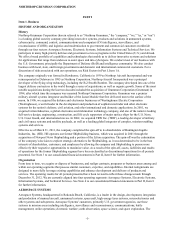Northrop Grumman 2012 Annual Report Download - page 20
Download and view the complete annual report
Please find page 20 of the 2012 Northrop Grumman annual report below. You can navigate through the pages in the report by either clicking on the pages listed below, or by using the keyword search tool below to find specific information within the annual report.
NORTHROP GRUMMAN CORPORATION
-10-
Competition within our markets and an increase in bid protests may reduce our revenues and market share.
We operate in highly competitive markets and our competitors may have more extensive or more specialized
engineering, manufacturing and marketing capabilities or be willing to accept more risk or lower margins in
competing for contracts. We have seen, and anticipate that we will continue to see, increased competition in some of
our core markets, especially as a result of the reduction in budgets for many U.S. Government agencies and fewer
new program starts. Changes in U.S. defense spending may limit certain future market opportunities. We are facing
increasing competition in our domestic and international markets from U.S., foreign and multinational firms.
Additionally, some customers, including the DoD, may turn to commercial contractors, rather than traditional
defense contractors, for information technology and other support work, or may utilize small business contractors or
determine to source work internally rather than hiring a contractor. If we are unable to continue to compete
successfully against our current or future competitors, we will experience declines in revenues and market share,
which would negatively impact our financial position, results of operations, or cash flows.
We also are seeing an increasing number of bid protests from unsuccessful bidders on new program awards. Bid
protests could result in significant expense to the company, contract modifications or the award decision being
overturned and loss of the contract award. Even where a bid protest does not result in the loss of an award, the
resolution can extend the time until the contract activity can begin, and delay earnings.
Our future success depends, in part, on our ability to develop new products and new technologies and maintain
technologies, facilities, equipment and a qualified workforce to meet the needs of current and future customers.
Many of the markets in which we operate are characterized by rapidly changing technologies. The product, program
and service needs of our customers change and evolve regularly. Our success in the competitive defense industry
depends upon our ability to develop and market our products and services, as well as our ability to provide the
people, technologies, facilities, equipment and financial capacity needed to deliver those products and services with
maximum efficiency. If we fail to maintain our competitive position, we could lose a significant amount of future
business to our competitors, which would have a material adverse effect on our ability to generate favorable
financial results and maintain market share.
Our operating results are heavily dependent upon our ability to attract and retain sufficient personnel with requisite
skills and/or security clearances. If qualified personnel become scarce, we could experience higher labor, recruiting
or training costs in order to attract and retain such employees. Failure to maintain a qualified workforce would result
in difficulty in performing under our contracts.
Approximately 3,300 of our 68,100 employees are covered by an aggregate of 17 collective bargaining agreements,
and we expect to negotiate or re-negotiate renewals for three of our collective bargaining agreements in 2013.
Collective bargaining agreements generally expire after three to five years, and are subject to renegotiation upon
expiration. We may experience difficulties with renewals and renegotiations of existing collective bargaining
agreements. If we experience such difficulties, we could incur additional expenses and may be subject to work
stoppages. Any such expenses or delays could adversely affect programs served by employees who are covered by
collective bargaining agreements.
Many of our contracts contain performance obligations that require innovative design capabilities, are
technologically complex, require state-of-the-art manufacturing expertise or are dependent upon factors not
wholly within our control. Failure to meet these obligations could adversely affect our profitability and future
prospects.
We design, develop and manufacture technologically advanced and innovative products and services, which are
applied by our customers in a variety of environments. Problems and delays in development or delivery as a result of
issues with respect to design, technology, licensing and patent rights, labor, inability to achieve learning curve
assumptions, manufacturing materials or components could prevent us from achieving contractual requirements.
In addition, our products cannot be tested and proven in all situations and are otherwise subject to unforeseen
problems. Examples of unforeseen problems that could negatively affect revenue and profitability include loss on
launch of spacecraft, premature failure of products that cannot be accessed for repair or replacement, problems with
quality and workmanship, country of origin, delivery of subcontractor components or services and degradation of
product performance. These failures could result, either directly or indirectly, in loss of life or property. Among the
factors that may affect revenue and profits could be unforeseen costs and expenses not covered by insurance or
indemnification from the customer, diversion of management focus in responding to unforeseen problems, loss of
follow-on work, and, in the case of certain contracts, repayment to the government customer of contract cost and fee
payments we previously received.
























